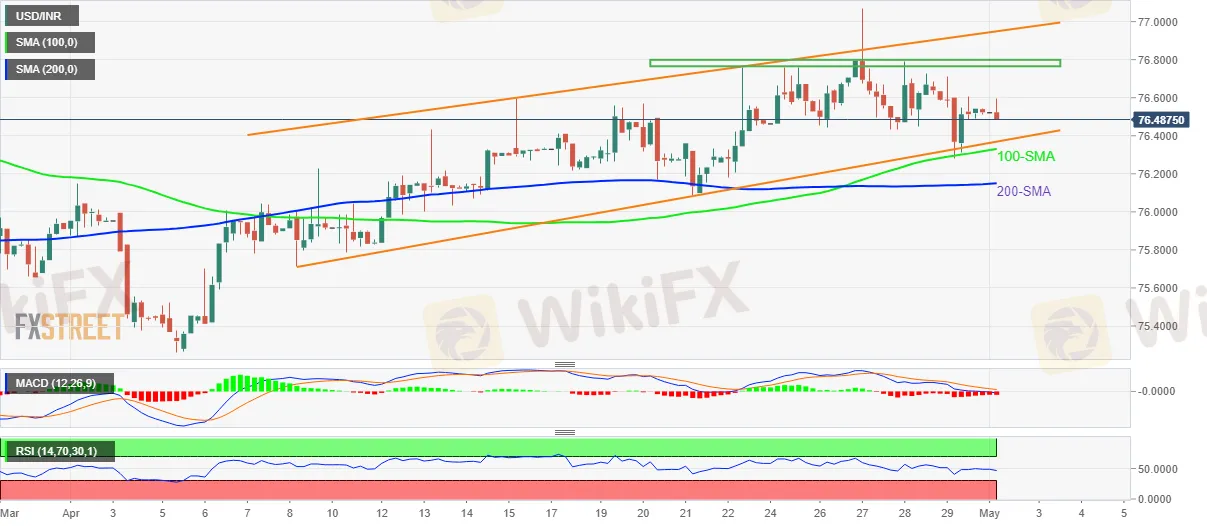简体中文
繁體中文
English
Pусский
日本語
ภาษาไทย
Tiếng Việt
Bahasa Indonesia
Español
हिन्दी
Filippiiniläinen
Français
Deutsch
Português
Türkçe
한국어
العربية
USD/INR Price Analysis: Rupee regains 76.50 despite Indias active covid cases jump to six-week high
Abstract:USD/INR renews intraday low around 76.48, extending the previous days weakness, as bears keep reins amid the initial hour of the Indian trading session on Monday.

USD/INR fades bounce off 100-SMA inside a bullish chart formation.
Indias active covid cases rally to the highest since March 25, crude prices refrain from declining.
Sluggish market sentiment, pre-Fed anxiety also challenge moves ahead of the key data/events.
US ISM Manufacturing PMI will direct intraday moves but major attention will be given to risk catalysts, Fed and NFP.
The Indian rupee (INR) pair‘s latest weakness ignores the resurgent covid woes and mostly firmer oil prices. Also challenging the INR bulls are the US dollar’s safe-haven appeal and the market‘s risk for risk-safety due to the Ukraine-Russia crisis, as well as China’s coronavirus-led lockdowns. It should be noted that the greenback‘s consolidation ahead of this week’s key data/event seems to have helped the USD/INR sellers of late.
As per the latest official update, India reports the highest active COVID-19 cases since March 25, per Reuters. That said, the daily infections eased to 3,157 versus 3,324 while the daily death toll also dropped from 40 to 26.
Elsewhere, the International Monetary Fund (IMF) also conveyed economic fears for the Asia-Pacific region, including India, while saying, “Economic growth in Asia and the Pacific will slow this year to 4.9%, less than last years 6.5% pace, amid the war in Ukraine, a resurgent pandemic, and rising interest rates.” For India, the IMF expects 8.2% growth in 2022 versus 8.9% for 2021.
Looking forward, the US ISM Manufacturing PMI for April, expected at 58.0 versus 57.1 prior, will offer intraday directions while major attention will be given to Wednesday‘s Fed meeting and Friday’s US NFP data. Should the Fed disappoint markets, the bears may return to the table.
Technical analysis
USD/INR remains inside a monthly rising channel, recently fading the bounce off 100-SMA.
Given the steady RSI and bearish MACD signals, as well as the pairs inability to cross the 76.75-80 region, the USD/INR bears remain hopeful.
However, the quotes successful trading above the key SMAs and the bullish cross of the 100-SMA over the 200-SMA hints at a short-term recovery.
Hence, intraday buyers may aim for the 76.75-80 region while any further upside will be challenged by the stated channels resistance line close to the 77.00 threshold.
Alternatively, the 100-SMA and the 200-SMA, respectively around 76.35 and 76.15, will test the USD/INR bears before giving them control.
USD/INR: Four-hour chart

Disclaimer:
The views in this article only represent the author's personal views, and do not constitute investment advice on this platform. This platform does not guarantee the accuracy, completeness and timeliness of the information in the article, and will not be liable for any loss caused by the use of or reliance on the information in the article.
Read more

Charles Schwab Review: Traders Claim Illegitimate Profit Cancellation, Trade Manipulation & More
Have you been lured into the Charles Schwab app for trading on the back of outrageous profit claims by the broker? Did you fail to receive any of these? Does the broker deny withdrawals every time you request and cancel your forex trading account? Have you been victimized financially by its trade manipulation? Act before you are left with a NIL balance in your account. Many traders have questioned Charles Schwab customer service and many other operational executives for the aforementioned illegitimate trading activities. In this Charles Schwab review article, we have shared some of their comments. Read on!

AMP Futures Exposed: Traders Raise Alarms Over Illegitimate Account Blocks & Bad Customer Service
Has AMP Futures blocked your forex trading account? Does it fail to provide any explanation for this act? Do you face issues concerning deposits to your AMP Futures account? Is the customer service non-existent for any trading query you raise with it? You are not alone! Many traders have been facing these issues upon AMP Futures login. Some of them have commented on AMP Futures review platforms. In this article, we have shared some reviews that you can look at. Read on!

FXGlory Review: Vanishing Profits, Capital Scams & Withdrawal Charges Keep Annoying Traders
Does FXGlory remove all your forex trading account balances upon fund withdrawal requests? Or do you witness incorrect trading account balances after fund withdrawals? Does the Saint Lucia-based forex broker charge you for fund withdrawals? All these and many more scam-related complaints have been filed against the forex broker. In this FXGlory review article, we will discuss several complaints. Read on!

PINAKINE Broker Review: A Complete Look at Its Services and Risks
Finding a trustworthy broker from the huge and often confusing world of online trading options is one of the biggest challenges a trader faces. In this competitive market, PINAKINE Liquidity Limited has appeared, getting attention with promises of high leverage and zero-commission trading. However, a closer look shows important factors that every potential client must think about before investing. The most important thing to consider with PINAKINE is that it has no regulation. This fact completely changes how risky the broker is and has major effects on how safe your investments will be. This review gives a complete and fair examination based on information available to the public. We will break down its services, trading conditions, platform technology, and the possible risks involved, helping you make a fully informed decision.
WikiFX Broker
Latest News
Voices of the Golden Insight Award Jury | Tim Waterer, Chief Market Analyst of KCM Trade
Stonefort Securities Review: A Fair Look at Safety, Rules, and What Traders Say
Trump asks for meat packer probe over beef prices
BASF CEO: EU CO₂ Trading Is A "Destruction Mechanism" For European Industry
Prop Firm Scams: When ‘Getting Funded’ Costs You Everything
PINAKINE Broker Review: A Complete Look at Its Services and Risks
One-Click Access to Broker Official Group Chats & Exclusive VPS Benefits
Easy Money Doesn't Exist! High-Return Promise Turned into an RM44,000 Scam
FXGlory Review: Vanishing Profits, Capital Scams & Withdrawal Charges Keep Annoying Traders
Charles Schwab Review: Traders Claim Illegitimate Profit Cancellation, Trade Manipulation & More
Currency Calculator




